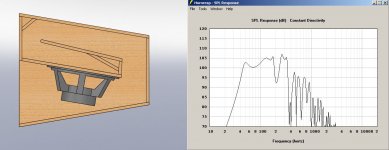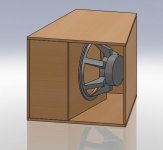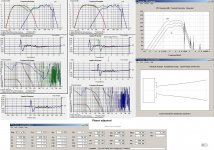This is not a completely Subwoofer-related topic, but since most TH-postings seem to end up here, I’ll have a go anyway… 😱
I’m looking for some advice regarding the construction of a tapped horn to be used in the frequency range between a conventional sealed woofer array and a tractrix upper bass horn. As of today, the horn extends down to around 130 Hz, after which the woofer array takes over. The integration of these two is not quite as seamless as I would like – the woofers are used above their comfort zone and this manifests itself quite clearly. I would of course like to introduce a proper straight midbass horn, but this would pose too large a strain on domestic relations… 🙄
I have instead turned my interest to tapped horns. I have not heard one myself, but it seems that they might provide a good solution to my problem. I’m thinking of keeping the woofer array, but only using it for frequencies an octave or so lower than today. Apparently, a tapped horn with a reasonable bandwidth and low frequency extension (and compact dimensions) can be built– as proven by William Cowan with his 60Hz TH.
This horn is my prime candidate, but I have two questions/reservations that someone might be able to help me with:
First: Maybe this is a gross misconception, but the “mouth” of the 60Hz TH seems to be placed on the narrow end of the enclosure, meaning you either have to place the horn with the mouth facing upwards or else on some kind of stand. How high would you need to raise the horn to let a downwards facing mouth maintain its function?
Second: John Hasquin has come to the conclusion that using two drivers in a push-pull configuration can significantly reduce the distortion of a tapped horn. Since low distortion is one of my top priorities for my project, this proposition seems too attractive to ignore. Is it possible to modify the Cowan 60Hz to accommodate two drivers (without knowing, this seems highly unlikely), while still maintaining the wide bandwidth? Or would I be better off starting from scratch? (In which case I’ll really need some active support from the TH-experts…) 🙂
Thank’s in advance!
I’m looking for some advice regarding the construction of a tapped horn to be used in the frequency range between a conventional sealed woofer array and a tractrix upper bass horn. As of today, the horn extends down to around 130 Hz, after which the woofer array takes over. The integration of these two is not quite as seamless as I would like – the woofers are used above their comfort zone and this manifests itself quite clearly. I would of course like to introduce a proper straight midbass horn, but this would pose too large a strain on domestic relations… 🙄
I have instead turned my interest to tapped horns. I have not heard one myself, but it seems that they might provide a good solution to my problem. I’m thinking of keeping the woofer array, but only using it for frequencies an octave or so lower than today. Apparently, a tapped horn with a reasonable bandwidth and low frequency extension (and compact dimensions) can be built– as proven by William Cowan with his 60Hz TH.
This horn is my prime candidate, but I have two questions/reservations that someone might be able to help me with:
First: Maybe this is a gross misconception, but the “mouth” of the 60Hz TH seems to be placed on the narrow end of the enclosure, meaning you either have to place the horn with the mouth facing upwards or else on some kind of stand. How high would you need to raise the horn to let a downwards facing mouth maintain its function?
Second: John Hasquin has come to the conclusion that using two drivers in a push-pull configuration can significantly reduce the distortion of a tapped horn. Since low distortion is one of my top priorities for my project, this proposition seems too attractive to ignore. Is it possible to modify the Cowan 60Hz to accommodate two drivers (without knowing, this seems highly unlikely), while still maintaining the wide bandwidth? Or would I be better off starting from scratch? (In which case I’ll really need some active support from the TH-experts…) 🙂
Thank’s in advance!
Is it possible to modify the Cowan 60Hz to accommodate two drivers (without knowing, this seems highly unlikely), while still maintaining the wide bandwidth? Or would I be better off starting from scratch? (In which case I’ll really need some active support from the TH-experts…) 🙂
Thank’s in advance!
Sure, simply double the internal width dimension, and put the second driver in. Response should stay exactly unchanged, except a boost in efficiency and/or maximum spl.
To be honest, I can hardly believe a sealed woofer would have trouble playing to 130Hz... in what way does it have problems? Liter for liter, you can probably get higher efficiency for the 50-150 range from a vented box than a tapped horn - they may be small compared to traditional horns, but they're still pretty big.
Raising the TH about a mouth width will probably be adequate, but the long path length of the TH makes them a lot more directional in the 60-15 Hz range than a direct radiator, you generally would be better having the exit pointed towards your listening area.First: Maybe this is a gross misconception, but the “mouth” of the 60Hz TH seems to be placed on the narrow end of the enclosure, meaning you either have to place the horn with the mouth facing upwards or else on some kind of stand. How high would you need to raise the horn to let a downwards facing mouth maintain its function?
Although I have built TH for the range you are looking for
http://www.diyaudio.com/forums/subwoofers/216701-midbass-tapped-horns.html
I would not advise their use for your particular application, a dual 10" or 12" midbass would have less group delay and could still get plenty loud (a pair of dual 10" can do over 126 dB in room) and clean in the 60-150 Hz range.
Push-pull reduces even order harmonic distortion but leaves the "bad sounding" odd order harmonics, not always a good sonic choice.
Sure, simply double the internal width dimension, and put the second driver in. Response should stay exactly unchanged, except a boost in efficiency and/or maximum spl.
In that case, the TH would double it's volume. Which isn't a very attractive proposition, since I want to enjoy the advantages of tapped horns without making them almost as large as a "real" horn...
To be honest, I can hardly believe a sealed woofer would have trouble playing to 130Hz... in what way does it have problems? Liter for liter, you can probably get higher efficiency for the 50-150 range from a vented box than a tapped horn - they may be small compared to traditional horns, but they're still pretty big.
Well, the bass enclosures are - due to space restraints - bound to the room's corners (they go all the way from floor to ceiling, in order to couple to the room). Because of this, i can't move the horn-sections and the woofer-towers independently. The woofers can play to 130Hz, but integration is difficult. The horns have such a fast response, that it's a bit too easy to hear when the "slower" woofers take over. I'd like to maintain the quickness of horns a bit lower in range.
Also, I want (correctly or not) low distorsion. Tapped horns can have almost horn-like levels of distorsion, and I imagine this would render a more seamless integration possible. I think... 🙂
Raising the TH about a mouth width will probably be adequate, but the long path length of the TH makes them a lot more directional in the 60-15 Hz range than a direct radiator, you generally would be better having the exit pointed towards your listening area.
Maybe some sort of reflector could help? I'm thinking along the lines of Bruce Edgar's bass horns...
Although I have built TH for the range you are looking for
http://www.diyaudio.com/forums/subwoofers/216701-midbass-tapped-horns.html
Thank's for the link. In the thread, member Patrik Bateman suggests (I extrapolate his statement just a tiny bit) using a tapped horn in the 40-160Hz range. You don't have to defend his statements, of course - I just found it interesting.🙂
Push-pull reduces even order harmonic distortion but leaves the "bad sounding" odd order harmonics, not always a good sonic choice.
Yes, this seems to be the case. However, the reduction of even order harmonics doesn't make the levels of the odd order harmonics increase, they just don't mask them anymore. Not sure this would be a bad sonic choice in my situation...
Cube boxes are not the only fruit!
Hi Ayebee
Most TH designs are set out to acheive a decent path length in a rectangular section cabinet. The geometry usually does not lend itself to be shortened for a mid bass frequency.
As you mentioned the the simple Cowan 60HZ horn could be used as a basis for a mid bass TH.
If you would like to get a bit more flexibility with the design of your TH, I have a suggestion for a fold that might help. It is a prototype drawing I did a couple of years or so ago - since then the progression we have made towards designing high performance tapped horns has been amazing.😀
This fold could acheive the passband you are after. The difference being that it is based on a trapeziodal cabinet. This is a cutaway view of the plan. ie Looking down at the cabinet.
The design would need some development work. This was based on a 18" driver and is simmed in 2PI. Dimensions are 624 high 720 wide and 842 front to back
The 105db hump at 130 hz can be reduced by removing or adjusting the tapered piece of the horn throat from S1 to S2.😉
Regards
Martin (Xoc1)
Hi Ayebee
Most TH designs are set out to acheive a decent path length in a rectangular section cabinet. The geometry usually does not lend itself to be shortened for a mid bass frequency.
As you mentioned the the simple Cowan 60HZ horn could be used as a basis for a mid bass TH.
If you would like to get a bit more flexibility with the design of your TH, I have a suggestion for a fold that might help. It is a prototype drawing I did a couple of years or so ago - since then the progression we have made towards designing high performance tapped horns has been amazing.😀
This fold could acheive the passband you are after. The difference being that it is based on a trapeziodal cabinet. This is a cutaway view of the plan. ie Looking down at the cabinet.
The design would need some development work. This was based on a 18" driver and is simmed in 2PI. Dimensions are 624 high 720 wide and 842 front to back
The 105db hump at 130 hz can be reduced by removing or adjusting the tapered piece of the horn throat from S1 to S2.😉
Regards
Martin (Xoc1)
Attachments
Hi,
A few questions: Is your tractrix upper bass horn(horn lenght?) designed for a cutoff at 130 Hz in 2Pi or 0.5Pi and what signal-delay is added to the horn for proper summing at the XO.
b 🙂
A few questions: Is your tractrix upper bass horn(horn lenght?) designed for a cutoff at 130 Hz in 2Pi or 0.5Pi and what signal-delay is added to the horn for proper summing at the XO.
b 🙂
Thank's for your help, Martin and Bjorno!
Martin: Not sure what you mean by "more flexible"... Could you explain what you mean? Also: It's too big! Two times the volume of the Cowan 60Hz, and way bulkier. I could probably manage a TH higher than the C60Hz, but what you suggest simply won't fit in my living room... 😉
Bjorno: the horn is designed for a 140Hz cutoff at 2pi. Length about 80 cm. No delay is applied.
I wish I could say that I understand exactly what point you want to make with the measurements, but I don't (although I'm quite sure there is a very valid one). 🙂 Could you please elaborate a bit?
Martin: Not sure what you mean by "more flexible"... Could you explain what you mean? Also: It's too big! Two times the volume of the Cowan 60Hz, and way bulkier. I could probably manage a TH higher than the C60Hz, but what you suggest simply won't fit in my living room... 😉
Bjorno: the horn is designed for a 140Hz cutoff at 2pi. Length about 80 cm. No delay is applied.
I wish I could say that I understand exactly what point you want to make with the measurements, but I don't (although I'm quite sure there is a very valid one). 🙂 Could you please elaborate a bit?
Hi Ayebee
The Cowan horn is very simple with a single fold. This means that the horn has only one taper angle on its complete length. This may work but does not give much flexibility to adjust the horn path to achieve the desired frequency response.
The trapezoidal layout allows up to 3 differing tapers to be used on the horn path. This makes it more adaptable to be adjusted to achieve the required response with your chosen driver.
The layout was meant only as an example. The Cowan 60Hz horn used a 10" driver - My example used a 18" driver. The size of the horn may be reduced by using a smaller driver - the path length will need to be roughly the same to get the same frequency response.
The driver and size of the horn chosen depends on how loud you require the TH to be to match the rest of your system.🙂
The Cowan horn is very simple with a single fold. This means that the horn has only one taper angle on its complete length. This may work but does not give much flexibility to adjust the horn path to achieve the desired frequency response.
The trapezoidal layout allows up to 3 differing tapers to be used on the horn path. This makes it more adaptable to be adjusted to achieve the required response with your chosen driver.
The layout was meant only as an example. The Cowan 60Hz horn used a 10" driver - My example used a 18" driver. The size of the horn may be reduced by using a smaller driver - the path length will need to be roughly the same to get the same frequency response.
The driver and size of the horn chosen depends on how loud you require the TH to be to match the rest of your system.🙂
- Status
- Not open for further replies.
- Home
- Loudspeakers
- Subwoofers
- Alternatives for tapped horns in the 50-150 Hz range


